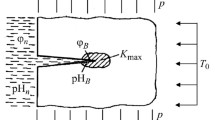Abstract
The problem of constructing a two-stage model of the motion of a fatigue crack in finite thin isotropic plates under symmetric tension-compression is formulated, and a method for its solution is considered. The two-stage nature is regarded as the presence of the incubation and propagation stages. The model is constructed by jointly considering the resolving equations of the theory of elasticity and the evolutionary equations of the mechanics of continuous damage. The damage function's attaining the critical value is considered as a criterion of initiation of local fracture and movement of a fatigue crack. Plates containing central and lateral cracks are considered. The effect of the level of stresses, the finiteness of the plate, the initial length of the crack, and the behavior of the length of the plastic zone on fracture kinetics is evaluated.
Similar content being viewed by others
References
A. E. Andreikiv,Spatial Problems of the Theory of Cracks [in Russian], Naukova Dumka, Kiev (1992).
V. V. Bolotin,Life of Machiens and Structures [in Russian], Mashinostroenie, Moscow (1990).
V. P. Golub, E. A. Panteleev, and A. V. Plashchinskaya, “Analysis of the fatigue longevity of plates containing stress concentrators with allowance for the two-stage nature of fracture,” in:Abstracts of Papers Read at 24th Sci. Meeting on the Dynamics and Strength of Motors [in Russian], Moscow (1992), pp. 17–18.
V. P. Golub and A. V. Plashchinskaya, “The cyclic longevity of thin cracked plates with allowance for the damage of the materials,” in:Abstracts of Papers Read at Sci. Meeting on Thermoviscoelastoplastic Deformation in Structural Elements [in Russian], Kiev (1992).
V. P. Golub and A. V. Plashchinskaya, “A model of fatigue fracture of thin isotropic cracked plates under axial loading,”Prikl. Mekh.,30, No. 4, 53–63 (1994).
A. A. Kaminskii,Nonclassical problems of Fracture Mechanics, Vol. 1,The Fracture of Viscoelastic Cracked Bodies [in Russian], Naukova Dumka, Kiev (1990).
L. M. Kachanov,Fundamentals of Fracture Mechanics [in Russian], Nauka, Moscow (1974).
S. Kotsan'da,The Fatigue Fracture of Metals [Russian translation], Metallurgiya, Moscow (1976).
M. Ya. Leonov and V. V. Panasyuk, “Development of smallest cracks in a solid,”Prikl. Mekh.,5, No. 4, 391–401 (1959).
O. N. Romaniv, S. Ya. Yarema, G. N. Nikiforchin, et al.,The Fatigue and Cyclic Crack Resistance of Structural Materials, Vol. 4 ofFracture Mechanics and the Strength of Materials: A Reference Book [in Russian], Naukova Dumka, Kiev (1990).
J. F. Knott,Fundamentals of Fracture Mechanics [Russian translation], Metallurgiya, Moscow (1978).
E. A. Panteleev, “One method of using singular solutions in boundary-value problems of the theory of elasticity,” in:Trans. 15th Sci. Conf. Young Scientists of the Institute of Mechanics Akad. Sci. Ukr. SSR, Part 1, Dep. VINITI 10.07.90, No. 3800-B90 (1990), pp. 104–109.
S. V. Serensen, V. P. Kogaev, and P. M. Shneiderovich,The Load-Carrying Capacity and Strength Analysis of Machine Parts [in Russian], Mashinostroenie, Moscow (1975).
V. T. Troshchenko, A. Ya. Krasovskii, V. V. Pokrovskii, et al.,The Strain and Fracture Resistance of Materials: A Reference Book [in Russian], Part 2 Naukova Dumka, Kiev (1994).
R. B. Heywood,Designing Against Fatigue [Russian translation], Mashinostroenie, Moscow (1969).
G. P. Cherepanov,Brittle-Fracture Mechanics [in Russian], Nauka, Moscow (1974).
D. S. Dugdale, “Yielding of steel sheets containing slits,”J. Mech. Phys. Solids,8, No. 2, 100–104 (1960).
V. P. Golub and E. A. Panteleyev, “Fatigue damage and cyclic lifetime of cracked isotropic plates considering two-stage fracture,” in:Fatigue 93. Proc. 5th Int. Congr. on Fatigue, IMAS, 1, New-York-Montreal (1993), pp. 275–281.
V. P. Golub, “The theory of long-term fatigue fracture providing for crack initiation and propagation,” in:Advances in Fracture Research, ICF9,3, Sydney (1997), pp. 1361–1370.
P. S. Paris and F. Erdogan, “A critical analysis of crack propagation laws,”Trans. ASME, J. Basic Eng.,D85, No. 4, 528–534 (1963).
J. R. Rice, “Mechanics of crack tip deformation and extension by fatigue crack propagation,”ASTM STP, Philadelphia (1967), pp. 247–309.
M. L. Williams, “On the stress distribution at the base of the stationary crack,”J. Appl. Mech.,24, No. 1, 109–114 (1957).
Additional information
The present work was carried out with financial support from the European Community in accordance with the INTAS-UA 95-0202 International Project.
S. P. Timoshenko Institute of Mechanics, National Academy of Sciences of Ukraine, Kiev. Translated from Prikladnaya Mekhanika, Vol. 36, No. 7, pp. 106–116, July, 2000.
Rights and permissions
About this article
Cite this article
Golub, V.P., Panteleev, E.A. Subcritical growth of high-cycle fatigue cracks in finite thin isotropic plates. Int Appl Mech 36, 938–947 (2000). https://doi.org/10.1007/BF02682303
Received:
Issue Date:
DOI: https://doi.org/10.1007/BF02682303




